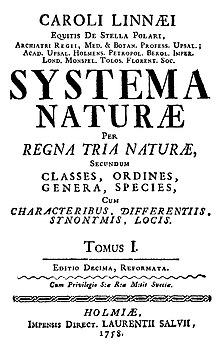
Linnaean taxonomy can mean either of two related concepts:
- The particular form of biological classification (taxonomy) set up by Carl Linnaeus, as set forth in his Systema Naturae (1735) and subsequent works. In the taxonomy of Linnaeus there are three kingdoms, divided into classes, and they, in turn, into lower ranks in a hierarchical order.
- A term for rank-based classification of organisms, in general. That is, taxonomy in the traditional sense of the word: rank-based scientific classification. This term is especially used as opposed to cladistic systematics, which groups organisms into clades. It is attributed to Linnaeus, although he neither invented the concept of ranked classification nor gave it its present form. In fact, it does not have an exact present form, as "Linnaean taxonomy" as such does not really exist: it is a collective (abstracting) term for what actually are several separate fields, which use similar approaches.
In biology, taxonomy is the scientific study of naming, defining (circumscribing) and classifying groups of biological organisms based on shared characteristics. Organisms are grouped into taxa and these groups are given a taxonomic rank; groups of a given rank can be aggregated to form a more inclusive group of higher rank, thus creating a taxonomic hierarchy. The principal ranks in modern use are domain, kingdom, phylum, class, order, family, genus, and species. The Swedish botanist Carl Linnaeus is regarded as the founder of the current system of taxonomy, as he developed a ranked system known as Linnaean taxonomy for categorizing organisms and binomial nomenclature for naming organisms.

Genus is a taxonomic rank used in the biological classification of living and fossil organisms as well as viruses. In the hierarchy of biological classification, genus comes above species and below family. In binomial nomenclature, the genus name forms the first part of the binomial species name for each species within the genus.

In taxonomy, binomial nomenclature, also called binary nomenclature, is a formal system of naming species of living things by giving each a name composed of two parts, both of which use Latin grammatical forms, although they can be based on words from other languages. Such a name is called a binomial name, a binomen, binominal name, or a scientific name; more informally it is also historically called a Latin name. In the ICZN, the system is also called binominal nomenclature, "binomi'N'al" with an "N" before the "al", which is not a typographic error, meaning "two-name naming system".

Family is one of the nine major hierarchical taxonomic ranks in Linnaean taxonomy. It is classified between order and genus. A family may be divided into subfamilies, which are intermediate ranks between the ranks of family and genus. The official family names are Latin in origin; however, popular names are often used: for example, walnut trees and hickory trees belong to the family Juglandaceae, but that family is commonly referred to as the "walnut family".

In biological classification, class is a taxonomic rank, as well as a taxonomic unit, a taxon, in that rank. It is a group of related taxonomic orders. Other well-known ranks in descending order of size are life, domain, kingdom, phylum, order, family, genus, and species, with class ranking between phylum and order.

In biological classification, subspecies is a rank below species, used for populations that live in different areas and vary in size, shape, or other physical characteristics (morphology), but that can successfully interbreed. Not all species have subspecies, but for those that do there must be at least two. Subspecies is abbreviated subsp. or ssp. and the singular and plural forms are the same.

In biology, a taxon is a group of one or more populations of an organism or organisms seen by taxonomists to form a unit. Although neither is required, a taxon is usually known by a particular name and given a particular ranking, especially if and when it is accepted or becomes established. It is very common, however, for taxonomists to remain at odds over what belongs to a taxon and the criteria used for inclusion, especially in the context of rank-based ("Linnaean") nomenclature. If a taxon is given a formal scientific name, its use is then governed by one of the nomenclature codes specifying which scientific name is correct for a particular grouping.

Systema Naturae is one of the major works of the Swedish botanist, zoologist and physician Carl Linnaeus (1707–1778) and introduced the Linnaean taxonomy. Although the system, now known as binomial nomenclature, was partially developed by the Bauhin brothers, Gaspard and Johann, Linnaeus was first to use it consistently throughout his book. The first edition was published in 1735. The full title of the 10th edition (1758), which was the most important one, was Systema naturæ per regna tria naturæ, secundum classes, ordines, genera, species, cum characteribus, differentiis, synonymis, locis, which appeared in English in 1806 with the title: "A General System of Nature, Through the Three Grand Kingdoms of Animals, Vegetables, and Minerals, Systematically Divided Into their Several Classes, Orders, Genera, Species, and Varieties, with their Habitations, Manners, Economy, Structure and Pecularities".

Species Plantarum is a book by Carl Linnaeus, originally published in 1753, which lists every species of plant known at the time, classified into genera. It is the first work to consistently apply binomial names and was the starting point for the naming of plants.
Botanical nomenclature is the formal, scientific naming of plants. It is related to, but distinct from taxonomy. Plant taxonomy is concerned with grouping and classifying plants; botanical nomenclature then provides names for the results of this process. The starting point for modern botanical nomenclature is Linnaeus' Species Plantarum of 1753. Botanical nomenclature is governed by the International Code of Nomenclature for algae, fungi, and plants (ICN), which replaces the International Code of Botanical Nomenclature (ICBN). Fossil plants are also covered by the code of nomenclature.
Nomenclature codes or codes of nomenclature are the various rulebooks that govern the naming of living organisms. Standardizing the scientific names of biological organisms allows researchers to discuss findings.
In botany, the phrase ordo naturalis, 'natural order', was once used for what today is a family. Its origins lie with Carl Linnaeus who used the phrase when he referred to natural groups of plants in his lesser-known work, particularly Philosophia Botanica. In his more famous works the Systema Naturae and the Species Plantarum, plants were arranged according to his artificial "Sexual system", and Linnaeus used the word ordo for an artificial unit. In those works, only genera and species were "real" taxa.

Lilianae is a botanical name for a superorder of flowering plants. Such a superorder of necessity includes the type family Liliaceae. Terminations at the rank of superorder are not standardized by the International Code of Nomenclature for algae, fungi, and plants (ICN), although the suffix -anae has been proposed.

Philosophia Botanica was published by the Swedish naturalist and physician Carl Linnaeus (1707–1778) who greatly influenced the development of botanical taxonomy and systematics in the 18th and 19th centuries. It is "the first textbook of descriptive systematic botany and botanical Latin". It also contains Linnaeus's first published description of his binomial nomenclature.

In biology, taxonomic rank is the relative level of a group of organisms in an ancestral or hereditary hierarchy. A common system of biological classification (taxonomy) consists of species, genus, family, order, class, phylum, kingdom, and domain. While older approaches to taxonomic classification were phenomenological, forming groups on the basis of similarities in appearance, organic structure and behaviour, methods based on genetic analysis have opened the road to cladistics.

Cultivated plant taxonomy is the study of the theory and practice of the science that identifies, describes, classifies, and names cultigens—those plants whose origin or selection is primarily due to intentional human activity. Cultivated plant taxonomists do, however, work with all kinds of plants in cultivation.

Critica Botanica was written by Swedish botanist, physician, zoologist and naturalist Carl Linnaeus (1707–1778). The book was published in Germany when Linnaeus was 29 with a discursus by the botanist Johannes Browallius (1707–1755), bishop of Åbo. The first edition was published in July 1737 under the full title Critica botanica in qua nomina plantarum generica, specifica & variantia examini subjiciuntur, selectoria confirmantur, indigna rejiciuntur; simulque doctrina circa denominationem plantarum traditur. Seu Fundamentorum botanicorum pars IV Accedit Johannis Browallii De necessitate historiae naturalis discursus.

The 12th edition of Systema Naturae was the last edition of Systema Naturae to be overseen by its author, Carl Linnaeus. It was published by Laurentius Salvius in Holmia (Stockholm) in three volumes, with parts appearing from 1766 to 1768. It contains many species not covered in the previous edition, the 10th edition which was the starting point for zoological nomenclature.

BurmannialesMart. was an order of monocotyledons, subsequently discontinued.















